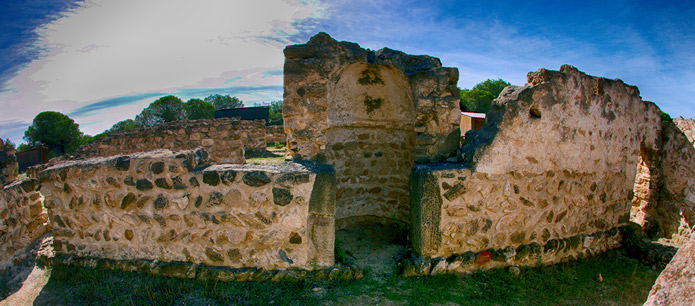
Guardamar Archaeological Heritage
The Islamic Caliphate Ribat

The mediaeval Islamic Caliphate ‘Rabita’ is situated in Park Alfonso XIII next to the site of the Phoenician city of La Fonteta near the River Segura’s mouth.
It was discovered in the late 19th century by Forestry Engineer Mr. Francisco Mira Botella, director of the Guardamar Dunes Reforestation Project. During reforestation stone structures appeared, containing a foundation stone written in classical Arabic. However, it was not until 1984 when the remains that can be seen today were surfaced. The site was declared a Site of Cultural Interest (SCI).
It is the only monastic Islamic monument from the Umayyad Andalusian period (X-XI century AD) preserved almost completely. It consists of 23 praying cells, with its own Mihrab, organised around two main streets. In this monastery, you would have found religious men, the faithful who stayed here and pilgrims performing the Ribat. They were all attracted by the spiritual retreat required by Islam to its followers.
The finding of this ribat is remarkable for its uniqueness. It is the first example of this type of religious building in the Iberian Peninsula.
The foundation headstone
The finding of Engineer Francisco Mira was a red sandstone headstone commemorating the founding of a mosque in AD 944, under the mandate of Caliph Abd Ar-Harman III. The original headstone is now in the Archaeological Museum of Murcia. However, a replica is now in its original place.
Structure
It consists of 23 praying cells attached one to the other, two complementary rooms and a mosque. All these rooms face two streets made up of three different areas: the sacred area, an area of reception of pilgrims and the area of the monastery where the stable population, made up of monks, lived.
The praying cells have a rectangular structure no more than 8 metres long and 3 metres wide, with a gateway and the wall with the Qiblah and the Mihrab.
The mosque also has a rectangular structure, also with a Qiblah wall and a Mihrab, but of much greater dimensions. It comprises two perpendicular naves to the Qiblah, a small adjoining room and 5 access doors. All the rooms had small windows that dimly lighted the space.
Although we can now see the stone of the praying cells they were originally plastered with mud and whitewashed. The exception was, however, the most important ones, which are still plastered today, with lime mortar, of much greater resistance. Small examples of painted decoration are found on some of the cells. These are bands with geometrical or vegetable patterns. A very simple decoration, thus reinforcing the idea of religion and mysticism.
Objects found
The objects found are typical ceramic dinnerware and utensils used for everyday use, scattered around the site, such as: oil lamps, kettles, jars, crocks, aqueducts, portable stoves, ataifors, plates and glass vials, etc. Many of these objects were complete and in good condition. Therefore, all this proves that the site was abandoned abruptly, probably due to an earthquake in the early 11th c. AD. This sudden abandonment is what has allowed for many objects to be found complete and some were still placed on their original usage spot.
There are other religious objects, such as the remains of rosary beads made up of clay pellets or fish bones.
The Inscriptions
Many examples of ancient Arabic writing are found inside the Guardamar ribat. The most important one is its foundation headstone, as well as an older and less well known headstone.
In addition pious Muslims who lived in this ribat and visiting pilgrims left a reminder of their stay will simple inscriptions on the walls.
